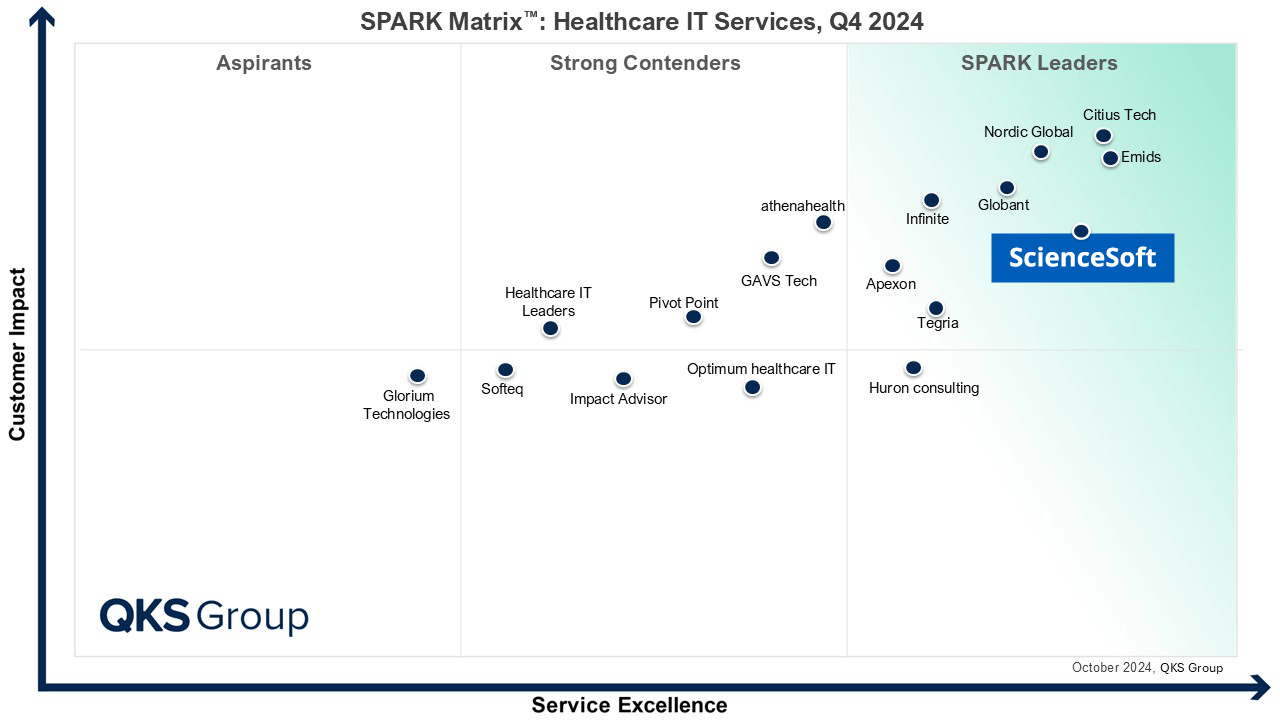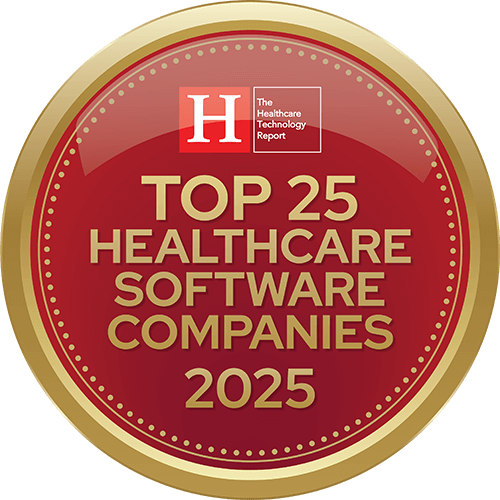Radiology Information System (RIS)
Features, Architecture, and Costs
With hands-on experience in healthcare image exchange and analysis and 20 years of healthcare IT practice, ScienceSoft builds robust, regulatory compliant RIS software for hospitals, diagnostic imaging centers, outpatient clinics, urgent care facilities, and other healthcare institutions.
A radiology information system is needed to streamline the management of medical imaging data and other radiology workflows, including scheduling, exam ordering and tracking, study reporting, inventory and equipment monitoring, billing management, and more.
A custom radiology information system is usually chosen by healthcare organizations that want to accommodate the unique demands of a particular department (e.g., orthopedics, breast imaging, oncology), specific integration requirements (e.g., integration with custom and legacy software, telehealth platforms, a patient portal), and a need to support multiple data exchange formats. Such solutions also allow organizations to benefit from ML/AI-powered features, such as voice recognition for report dictation and image analysis for facilitated diagnosing.
- Implementation time: 6 to 18+ months.
- Common integrations: PACS, EHR/EMR, VNA, telemedicine platforms, a customer portal.
- Costs: $200,000–$1,000,000+, depending on the solution's complexity. Use our free online calculator to get a custom quote from our consultants.
Radiology Information System Market Size is to Reach $18.9 Billion by 2032
According to Global Market Insights, the market is to grow at a CAGR of 12.6%. The major factors propelling the market include the growing number of imaging procedures, the increasing demand for efficient radiology workflow management, and high prevalence of chronic diseases.
High-Demand RIS Capabilities
Below, our experts provide an overview of core and advanced RIS features. Quite often, healthcare organizations choose to implement integrated RIS/PACS systems to benefit both from capabilities for radiology department management and for image exchange, storage, and analysis. Read our dedicated guide on PACS development to get an idea of how its image exchange, storage, and analysis capabilities can enhance an RIS.
Patient management
An RIS accumulates patient data, including patient demographics, examination details, imaging results, and referring physician information. A system enables patients’ radiology history tracking from admission to discharge. Such systems also have capabilities for scheduling imaging exams and procedures for in- and outpatient care, e.g., bulk scheduling, online booking and rescheduling for patients via patient portals, checking for appointment conflicts, setting up appointment reminders, managing referrals and waitlists.
Workflow management
Healthcare professionals (e.g., referring physicians, radiologists) can enter imaging orders directly into an RIS, via an integrated EHR/EMR or via a physician web portal and then track the status of an exam order and image location in real time. An RIS can also have capabilities for worklist management. That includes generation and customization of dynamic worklists, task assignment and monitoring, and automated population of worklists with radiology images from an integrated PACS.
Interoperability with other systems
An efficient RIS should enable bidirectional data exchange with back-office and external systems by supporting data exchange protocols (e.g., HL7 for clinical data, DICOM for imaging data). For example, an RIS can send patient and procedure data to a PACS and receive medical images from a PACS. It can also send imaging results to EHR/EMR for easy access by referring physicians and receive exam order and other patient data from it. Additionally, RIS can forward data to an HIE system for further sharing with other hospitals and professionals.
Resource management
An RIS helps to track the availability of equipment for different imaging modalities, its utilization rate, and maintenance schedules and logs to prevent equipment overbooking and conduct predictive maintenance. Such solutions also allow organizations to track the location of consumables, monitor their inventory levels, and enable automated reordering. Inventory transactions in a RIS can be entered with a barcode reader or via data entry screen.
QC management
An RIS helps keep record of the performed procedures, the responsible technologists, the used machine, the radiation dosage received by the patient, the quantity of used consumables, and exam repeats. The system can then build QC reports (e.g., procedures by technologist, repeats by reason and machine) that let organizations identify areas for improvement and enhance patient safety.
Specialty-specific modules
An RIS can feature modules with capabilities for managing specialty-specific imaging studies. These can include dedicated protocols (e.g., for different types of cancer in oncology), integrations (e.g., a cardiac risk assessment tool for cardiology studies), and specialized reporting templates (e.g., reports with BI-RADS scores and lay report letters for mammography studies).
Reporting and documentation
Basic reporting capabilities include customizable templates for structured report creation (e.g., with fields for study findings, recommendations), text editing tools for narrative reports, version control mechanisms, and secure distribution among staff and patients. Advanced capabilities allow for automated generation and auto-population of the reports with imaging study results, error-checking, and voice recognition for dictating reports (incl. from mobile devices).
Analytics and BI reporting
An RIS can monitor radiology KPIs (e.g., turnaround time, patient wait times, exam volume per time period) and provide interactive BI dashboards with capabilities for drilling up and down, slicing and dicing. Advanced solutions can provide ML/AI-powered recommendations on optimizing workflows and resource consumption.
Billing and financial management
An RIS can be used to generate invoices that can then be accessed by patients via a patient portal or sent to them by email. Administrative staff can use an RIS to track the status of payments from patients and insurance companies and get alerts on overdue payments. Other finance management capabilities of the system include automated charge entry, insurance eligibility checks, claim generation and submission, and financial KPI tracking (e.g., average days in accounts receivable, claim denial rates and reasons).
Security
An RIS can feature various mechanisms for sensitive data protection. They typically include data encryption at rest and in transit, role-based user access and multi-factor authentication, backup and disaster recovery, and other mechanisms. Such solutions also provide audit trails of all data-related actions, including entries and modifications to ensure complete accountability and facilitate incident investigation.
Sample Architecture of a Custom Radiology Information System
Below, our solution architects provide a sample architecture of a custom RIS.

Integration with back-office and external systems ensures RIS interoperability with them, e.g., due to that, physicians can request imaging orders via department-specific software like a surgery planning solution or via EHR/EMR that often has a shared interface with the RIS.
Healthcare professionals interact with the solution via web and mobile interfaces. Patients can use dedicated portals or telemedicine apps (e.g., to schedule an appointment).
User requests are directed to the RIS backend featuring services for different operations, e.g., worklist management for automated worklist generation, resource management for equipment availability tracking. To perform the required actions, all the services address the operational database and the database management system (DBMS). ML/AI-powered capabilities (e.g., NLP-driven voice recognition) are ensured by the ML/AI module.
The data governance and security framework enables data masking and encryption, role-based access, multi-factor authentication, data backup and recovery, and other measures that ensure data security, privacy, and integrity according to the relevant regulations like HIPAA and GDPR.
Custom RIS Development: Key Steps
Custom RIS development is needed when an organization wants a solution that has tailored capabilities for working with specialty-specific studies, managing workflows (e.g., scheduling, worklist management, inventory tracking), exchanging data with internal and external systems, and more. Since 2005 in custom healthcare software development, ScienceSoft provides a brief overview of key steps for RIS implementation.
1.
Business analysis and requirement engineering
The specifics of this step will largely depend on the intended use of the future solution. If the RIS is developed for commercial distribution among healthcare organizations, business analysts communicate with a company’s product manager, sponsors, a project manager, and other stakeholders to understand their vision for the software (e.g., features they want to include, end users they want to target). The experts then analyze the market, suggest the optimal market niche, and define product differentiation characteristics.
When a solution is developed for internal use, the experts collaborate with radiologists, administrative staff, CIO, and other organization’s representatives to elicit their requirements for the solution and get a clear picture of the organization’s operational specifics (e.g., established workflows, the software and image modalities they use).
In both cases, apart from defining the feature set, the analysts need to determine user roles, map out user journeys, and gather requirements related to integration needs, deployment model (e.g., cloud or on-premises), platform availability (e.g., web, mobile), and regulatory compliance landscape (e.g., the need to comply with HIPAA, GDPR).
2.
Integration and architecture design
At this stage, solution architects plan the architecture components that will support the designed workflows. They also compare different storage, processing, analytics, reporting, security, orchestration, and other techs and then recommend those that perfectly balance costs and requirements for scalability, performance, and availability.
Apart from that, the specialists decide on optimal ways to integrate the RIS with required systems and outline the ways of standardizing data exchange processes in line with the required data exchange standards (e.g., DICOM, HL7).
At ScienceSoft, we often use cloud services of reputable providers. They feature ready-made components and low-code development options, which helps us deliver software up to 2-20x faster and eliminate costs associated with developing components from scratch.
3.
UX/UI design
UX and UI designers create workflows and design elements that make sure the software is user-friendly and easy to navigate. These could include quick access buttons to see patient clinical history, drag & drop functionality for appointment scheduling, image thumbnail previews, and more. In case there is a mobile app planned, designers create interfaces for smaller screens.
4.
Development and testing
It is a good practice to shift testing left, i.e., conduct it in parallel with development. That way, both teams work in close collaboration and defects are fixed before they enter later stages of the delivery cycle.
The development team also tries to find ways to optimize development costs without sacrificing quality. In ScienceSoft’s experience, implementing DevOps practices and feasible QA automation can help cut development costs by up to 78%.
5.
Deployment and support
The experts monitor the performance of the developed solution, identify remaining flaws, and fix them. Developers create exhaustive software documentation (e.g., maintenance guides, instructions on API usage) as well as training materials for users. At ScienceSoft, we provide one-month post-launch warranty where we fix major software issues free of charge.
How Much Does It Cost to Develop a Custom RIS?
The cost of custom RIS development may range between $200,000 and $1,000,000+. The major cost factors include the scope of operations it covers, the number of integrations, the number of users, the complexity of provided capabilities, and the range of supported modalities.
|
|
Basic solution |
Solution of medium complexity |
Advanced solution |
|---|---|---|---|
|
The scope of operations covered by the system
|
|
|
|
|
Integration and interoperability
|
|
|
|
|
Web and mobile apps for doctors
|
|
|
|
|
Number of users
?
A large number of users may influence the cost as it requires implementing load balancing mechanisms to ensure the system’s stable performance. |
Up to 20 |
Up to 100 |
Up to 500 |
|
Supported image modalities
?
Multiple modalities may influence the cost as they require additional efforts for standardizing data exchange processes. |
|
|
|
|
Billing and financial management features
|
|
|
|
|
Integration with a patient portal
|
|
Up to 5,000 users |
5,000+ users |
|
Reporting and documentation features
|
|
|
|
|
Analytics and reporting
|
|
|
|
|
Costs
|
$200,000-$300,000 |
$300,000-$500,000 |
$500,000-$1,000,000+ |
Why Choose ScienceSoft as Your RIS Development Partner?
- Since 2005 in healthcare IT with 150+ successful projects.
- Experience in achieving compliance with HIPAA, GDPR, and other regulatory standards.
- Since 1989 in AI and machine learning
- Since 2013 in image analysis software development.
- Proficiency in healthcare data exchange standards, including HL7, DICOM, ASTM, and more.
- ISO 9001-certified quality management and ISO 27001-certified information security management.
Our awards and partnerships

Featured among Healthcare IT Services Leaders in the 2022 and 2024 SPARK Matrix
Recognized for Healthcare Technology Leadership by Frost & Sullivan in 2023 and 2025
Named among America’s Fastest-Growing Companies by Financial Times, 4 years in a row

Top Healthcare IT Developer and Advisor by Black Book™ survey 2023
Recognized by Health Tech Newspaper awards for the third time (2022, 2023, 2025)

Named to The Healthcare Technology Report’s Top 25 Healthcare Software Companies of 2025
ISO 13485-certified quality management system
ISO 27001-certified security management system



